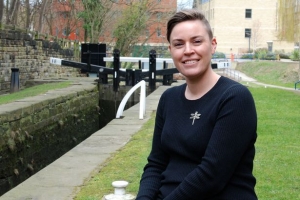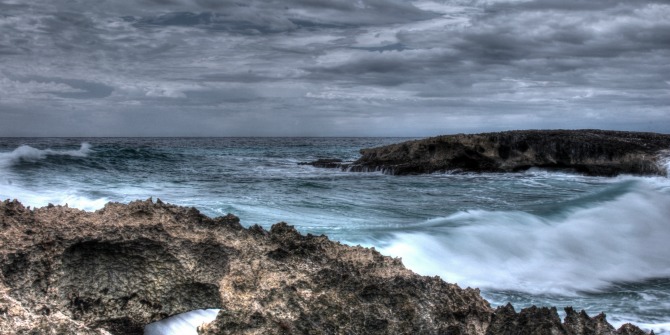 In this feature essay, Jodie Matthews examines how waterways have not just been the topic of her work, but have also become a dominant material metaphor that has channelled her theoretical approach. Tracing the history of the ‘canal age’ and how it continues to influence our physical and conceptual landscapes, this essay discusses how river navigations offer generative ways of considering the materiality of humanities research.
In this feature essay, Jodie Matthews examines how waterways have not just been the topic of her work, but have also become a dominant material metaphor that has channelled her theoretical approach. Tracing the history of the ‘canal age’ and how it continues to influence our physical and conceptual landscapes, this essay discusses how river navigations offer generative ways of considering the materiality of humanities research.
This essay is part of a series examining the material cultures of academic research, reading and writing. If you would like to contribute to the series, please contact the Managing Editor of LSE Review of Books, Dr Rosemary Deller, at lsereviewofbooks@lse.ac.uk.
Flows of Thought: On Canals, Materiality and Humanities Research

Image Credit: Canal and River Trust
The University of Huddersfield campus in West Yorkshire is bisected by the Huddersfield Narrow Canal. This waterway, completed in 1811, was designed as a trade route across – or, rather dramatically, beneath – the Pennines. My own research is about the representation of people who travelled around Britain for work and as a cultural practice in the nineteenth century. When I had newly arrived in Yorkshire in 2009, the view from my office window made it impossible to ignore the connections I had begun to see between the textual attitudes to travelling Romani people I examined in my doctoral work and those towards the men, women and children who once plied Britain’s canals. The materiality of my research location determined, at that point, my research focus.
Since then, waterways have not just been the topic of, but also a dominant metaphor in the way I conceptualise my work. To put it another way, the materiality of the canal has channelled my thinking. I started simply with the people who worked the canals, but have been steered towards writing about the important but often neglected place of the canals in British culture – from Anna Letitia Barbauld’s ambivalent wonder at the Barton aqueduct in 1773 to Lee Rourke’s post-industrial canalside meditation on boredom. We are extremely lucky in this country to still be able to use, sit by and walk along historic canals and basins, thanks to the hard work of volunteers, organisations such as the Huddersfield Canal Society and the charity with which I have recently been working, the Canal & River Trust.
Some consider these waterways and their handy towpaths to be ‘linear parks’, while for others they are a route to work, a space for community engagement or a wildlife refuge. Walking has long been associated with thinking, and the steady pace of a canalside walk is conducive to creative thought and reflection. Here, that reflection is literal: the rippled image of dog walkers and joggers and day trippers takes the place of the canal boat people, lock keepers and tourists of centuries earlier. For someone like me, thinking about the history of the canals themselves, a stride along the Tardebigge Flight or the Calder and Hebble Navigation is a boon indeed. To have such a material connection with the built environment of the past, a way of retracing journeys, is inspiring.
 The canal is also known as ‘the cut’. This was, and continues to be, a widely-used term, but a historical example can be found in the title of a Victorian children’s book, Amos Reade’s Life in the Cut (1888). The violence of digging a new route through and into the landscape lives on in this colloquialism. For instance, the Countess of Bridgewater suggested that the London and Birmingham Railway should be routed through her property alongside the Grand Junction Canal because the land was ‘already gashed by the canal’.
The canal is also known as ‘the cut’. This was, and continues to be, a widely-used term, but a historical example can be found in the title of a Victorian children’s book, Amos Reade’s Life in the Cut (1888). The violence of digging a new route through and into the landscape lives on in this colloquialism. For instance, the Countess of Bridgewater suggested that the London and Birmingham Railway should be routed through her property alongside the Grand Junction Canal because the land was ‘already gashed by the canal’.
But this digging of a new route also brings to my mind Sigmund Freud’s conception of pathbreaking or breaching (Bahnung), revisited by Jacques Derrida in ‘Freud and the Scene of Writing’. This is a very different sort of route being dug, but connecting the image of the canal being cut and the making of memory has been a useful way for me to think about our cultural memory of canals. For Freud, a memory trace is laid down when a perception breaks through resistance in the psyche. Derrida even calls this ‘mole-like’, which I link to Barbauld’s description of men digging the canal, the ‘sons of toil’, who ‘scoop the hard bosom of the solid rock’ with ‘many a weary stroke’ (‘The Invitation’, 1773). As perception lays a path in the psyche, so the canal builders cut through the landscape.
Derrida is profoundly interested in memory and writing. In my own research, I see myself investigating the meaning of that pathbreaking cut in texts from the past, producing (as Derrida would have it) a present past. To analogise the digging of the canal and the breaching of the memory trace in the psyche is to enable different ways of reading historical representations of canals, and thus a theoretical approach to understanding the place of canals in the national psyche. What does it mean today to think about the cultural history of waterways in Britain? Which canal memories do we revisit and reproduce, and which are forgotten? What is the present past of the cut? This approach may seem rather specific to my own work on the representation of canals and their communities, but I suggest that the materiality of the waterways has much to offer researchers working in other areas too.
The early river navigations and waterways of the ‘canal age’ in Britain were all for the purpose of communication, but they were not originally conceived as a complete network: coal from the Lancashire coalfield to Liverpool; salt to the Mersey and onward to Ireland. Once the potential of the waterways became clear, however, trunk routes were developed. By the end of the eighteenth century, the Mersey was linked to the Severn, the Thames with the Bristol Channel, and Hull communicated directly with Liverpool. By 1822 there were 4000 miles of navigable waterways in Britain. We understand our twenty-first-century world as and via social communications and digital networks. One would be hard-pushed to find an academic discipline that does not at some point reference ‘network theory’ – in fact, understanding networks is what often brings disciplines together. Academics travelling to UK conferences by train (sometimes with the view to ‘networking’) and catching glimpses of the canal often running in parallel with the railway could think of the ways in which their understanding of networks is inflected by the material remainder of this centuries-old one. The canal age and the industry and innovation it heralded fundamentally changed Britain – and, perhaps, the planet, if one considers the carbon impact of efficiently connecting coalfields to industry for the first time. A network we can map, walk along and see is a noteworthy material resource when considering our interconnected global existence.
As Katie Collins demonstrated so powerfully in a previous post for this series, ‘as well as communicating what we mean, metaphors structure our thinking’. River ‘navigations’ predated canals and were part of the network I describe above, and this is already a familiar metaphor for rigorous thought. We ‘navigate’ systems, bureaucracies, policies and institutions, but also our way through complex ideas, turbulent times or confusing information. Making rivers navigable means dredging them (removing that which impedes the navigation); reinforcing the banks (ensuring stability); deepening (to enable continuous flow); and straightening (taking as direct and appropriate a path as possible). The building of canals is just as useful for thinking about one’s place in a research landscape: what is the existing terrain? What mechanisms or innovation are required to proceed with navigation? Which specialist areas require a specific route? What intersections are helpful?
 What makes transport by waterway possible and desirable are, of course, the qualities of water. In Liquid Modernity, Zygmunt Bauman emphasises the ‘extraordinary mobility of fluids’. That mobility is what made the waterways a means of moving materials – coal, cotton, wool, salt, timber, manufactured goods, textiles, pottery and people – with their news, ways of life and modes of speech. Bauman also notes that when describing fluids, ‘to leave time out of account would be a grievous mistake. Descriptions of fluids are all snapshots, and they need a date at the bottom of the picture.’
What makes transport by waterway possible and desirable are, of course, the qualities of water. In Liquid Modernity, Zygmunt Bauman emphasises the ‘extraordinary mobility of fluids’. That mobility is what made the waterways a means of moving materials – coal, cotton, wool, salt, timber, manufactured goods, textiles, pottery and people – with their news, ways of life and modes of speech. Bauman also notes that when describing fluids, ‘to leave time out of account would be a grievous mistake. Descriptions of fluids are all snapshots, and they need a date at the bottom of the picture.’
The water I peer into is long gone; the surface that reflects the dog walkers and joggers and day trippers is not the same as the surface I am researching. To research water is to think about time. That insistent movement of fluids was the condition for the canal’s invention, and the difficulties it caused (how to prevent leaking; how to move water uphill) were also what demanded engineering innovation. Partially controlled, fluid movement demanding creativity, learning and nous seems an appropriate aspiration for academic work. In the Introduction to their ambitious collection, Thinking with Water, Cecilia Chen et al point to and encourage a ‘hydrological turn’ in interdisciplinary academic research, suggesting that waters ‘gather stories, identities, and memories’. They deploy the metaphors of immersion, confluence, currents, flow, circulation and, intriguingly, the situatedness of water. It is with these generative metaphors in mind that I proceed with investigating the particularity and politics of the canals and all that they carried.
Note: Thank you to Jodie Matthews and the Canal and River Trust for providing images for this feature essay. This article gives the views of the author, and not the position of the LSE Review of Books blog, or of the London School of Economics and Political Science.








Jodie, would you like to be in touch? I am writing a book about the English canals focusing on the spirituality of the experience of narrow-boating – something I have been enjoying for 20 years. I want to enrich the concept of the stillwater-ways and provide imagery that will articulate the popular appreciation that exists..
It may be that we have plenty to talk about.
Dear Charlie
That sounds like a fascinating project. Drop me a line at j.matthews@hud.ac.uk so I have your email address.
Jodie
this is a very ineresting to read, thank you for sharing this post. I want to enrich the concept of the stillwater-ways and provide imagery that will articulate the popular appreciation that exists.